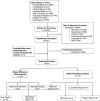Prenatal exposure to cannabis and maternal and child health outcomes: a systematic review and meta-analysis
- PMID: 27048634
- PMCID: PMC4823436
- DOI: 10.1136/bmjopen-2015-009986
Prenatal exposure to cannabis and maternal and child health outcomes: a systematic review and meta-analysis
Abstract
Objective: To assess the effects of use of cannabis during pregnancy on maternal and fetal outcomes.
Data sources: 7 electronic databases were searched from inception to 1 April 2014. Studies that investigated the effects of use of cannabis during pregnancy on maternal and fetal outcomes were included.
Study selection: Case-control studies, cross-sectional and cohort studies were included.
Data extraction and synthesis: Data synthesis was undertaken via systematic review and meta-analysis of available evidence. All review stages were conducted independently by 2 reviewers.
Main outcomes and measures: Maternal, fetal and neonatal outcomes up to 6 weeks postpartum after exposure to cannabis. Meta-analyses were conducted on variables that had 3 or more studies that measured an outcome in a consistent manner. Outcomes for which meta-analyses were conducted included: anaemia, birth weight, low birth weight, neonatal length, placement in the neonatal intensive care unit, gestational age, head circumference and preterm birth.
Results: 24 studies were included in the review. Results of the meta-analysis demonstrated that women who used cannabis during pregnancy had an increase in the odds of anaemia (pooled OR (pOR)=1.36: 95% CI 1.10 to 1.69) compared with women who did not use cannabis during pregnancy. Infants exposed to cannabis in utero had a decrease in birth weight (low birth weight pOR=1.77: 95% CI 1.04 to 3.01; pooled mean difference (pMD) for birth weight=109.42 g: 38.72 to 180.12) compared with infants whose mothers did not use cannabis during pregnancy. Infants exposed to cannabis in utero were also more likely to need placement in the neonatal intensive care unit compared with infants whose mothers did not use cannabis during pregnancy (pOR=2.02: 1.27 to 3.21).
Conclusions and relevance: Use of cannabis during pregnancy may increase adverse outcomes for women and their neonates. As use of cannabis gains social acceptance, pregnant women and their medical providers could benefit from health education on potential adverse effects of use of cannabis during pregnancy.
Keywords: PREVENTIVE MEDICINE; PUBLIC HEALTH.
Published by the BMJ Publishing Group Limited. For permission to use (where not already granted under a licence) please go to http://www.bmj.com/company/products-services/rights-and-licensing/
Figures
References
-
- WHO. Management of substance abuse: Cannabis. 7 July 2015. http://www.who.int/substance_abuse/facts/cannabis/en/
-
- Crime, U.N.O.o.D.a. World drug report. 2014. http://www.unodc.org/documents/wdr2014/World_Drug_Report_2014_web.pdf
-
- Board, I.N.C, U.N.V.I. Centre, and Austria. International Narcotics Control Board: 2013 Annual Report, 2013.
Publication types
MeSH terms
LinkOut - more resources
Full Text Sources
Other Literature Sources
Medical
Research Materials
Miscellaneous

